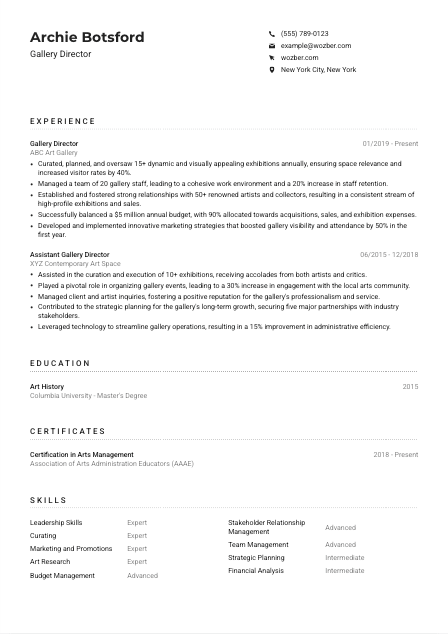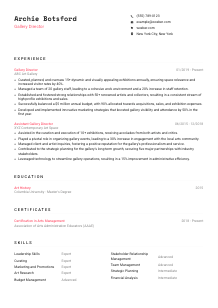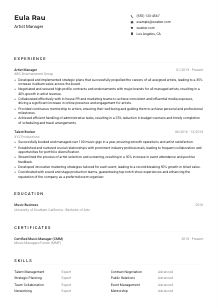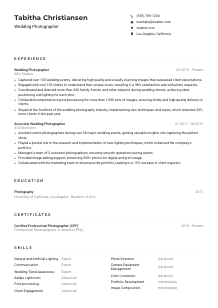Gallery Director Resume Example
Curating exhibitions, but your resume isn't in the spotlight? Bask in this Gallery Director resume example, styled with Wozber free resume builder. Discover how effortlessly you can present your artistic leadership to meet the career vision and exhibition expectations set for the role!

How to write a Gallery Director Resume?
Hello, esteemed future Gallery Director! As you step into the world of curating the remarkable and leading artistic endeavors, your resume is not just a piece of paper; it's the narrative of your passion, experience, and leadership in the arts. With the competitive landscape of today's job market, it's crucial to craft a resume that speaks volumes to your unique qualifications.
Harnessing the power of the Wozber free resume builder, we're here to guide you through creating a resume that's not only a reflection of your talent but also meticulously tailored to the specific Gallery Director position you're eyeing. Let's embark on this creative journey together, turning your resume into a work of art that will leave hiring managers in awe.
Personal Details
First impressions matter immensely, and in the world of resumes, your Personal Details section is the grand opening. It's here that we establish a solid foundation, ensuring every inch of this introduction is perfectly sculpted to meet the expectations of a Gallery Director application. Let's dive into the nuances of personalizing this section with the utmost precision.
1. Illuminate Your Name
Think of your name as the title of your gallery exhibition; it needs to captivate and hold attention. Ensure it's prominently displayed in a clear, professional font, acting as the beacon that guides the hiring manager through your artistic career journey.
2. Embrace Your Title
Below your name, proudly display your current or aspirational role - 'Gallery Director'. This not only shows confidence but immediately aligns your resume with the job at hand, ensuring the hiring manager knows exactly what scene you're setting.
3. Craft Your Contact Ensemble
In a world where communication is key, providing your phone number and a professional email address is akin to handing out an invitation to your next grand exhibition. Use a straightforward format for your email—something like firstname.lastname@email.com will suffice. It's your digital handshake with the art world.
4. Pinpoint Your Locale
For a Gallery Director role, your location can be a significant asset, especially if you're based in art hubs like New York City. If you match the job's location requirement, make it known. This can ease any concerns about relocation and demonstrate your connection to the local art scene.
5. A Spoonful of Personal Branding
If you have a professional website, online portfolio, or LinkedIn profile that showcases your work or affiliations, include it. This is your chance to show the depth of your experience beyond the confines of a resume. It's like giving a prelude to your main exhibit.
Takeaway
Remember, the Personal Details section is your spotlight moment. It's the first brushstroke on your canvas. With precision and thoughtfulness, you're setting the tone for the masterpiece that is your career narrative. Make it compelling, and make it yours.





Experience
The Experience section is where your resume comes to life, weaving a rich tapestry of your professional journey. Here, we'll mold your experiences into a narrative that speaks directly to the heart of being a Gallery Director, emphasizing your leadership, innovation, and curatorial excellence.
- Curated, planned, and oversaw 15+ dynamic and visually appealing exhibitions annually, ensuring space relevance and increased visitor rates by 40%.
- Managed a team of 20 gallery staff, leading to a cohesive work environment and a 20% increase in staff retention.
- Established and fostered strong relationships with 50+ renowned artists and collectors, resulting in a consistent stream of high‑profile exhibitions and sales.
- Successfully balanced a $5 million annual budget, with 90% allocated towards acquisitions, sales, and exhibition expenses.
- Developed and implemented innovative marketing strategies that boosted gallery visibility and attendance by 50% in the first year.
- Assisted in the curation and execution of 10+ exhibitions, receiving accolades from both artists and critics.
- Played a pivotal role in organizing gallery events, leading to a 30% increase in engagement with the local arts community.
- Managed client and artist inquiries, fostering a positive reputation for the gallery's professionalism and service.
- Contributed to the strategic planning for the gallery's long‑term growth, securing five major partnerships with industry stakeholders.
- Leveraged technology to streamline gallery operations, resulting in a 15% improvement in administrative efficiency.
1. Frame Your Masterpieces
Begin by listing your experiences in reverse chronological order. Pay close attention to positions most relevant to a Gallery Director role, ensuring each role you list directly aligns with the expectations set by the job description.
2. Curate Your Contributions
For each position, craft accomplishment statements that resonate with the Gallery Director role. Did you increase visitor rates? Foster artist relations? Oversee budget management? These are your exhibitions; make them count.
3. Illuminate Your Achievements
Quantify your achievements wherever possible. Did your marketing strategy increase gallery attendance by 50%? Numbers are the gallery lights that make your accomplishments shine, providing tangible proof of your effectiveness.
4. Focus on Relevance
While it might be tempting to list every success, filter your experiences through the lens of the Gallery Director role. If certain achievements don't directly correlate, leave them for the portfolio. Keep your resume focused on the pieces most relevant to the gallery.
5. Embrace Your Artistic Narrative
Remember, each bullet point is a brush stroke in your larger professional picture. Aim to tell a compelling story of growth, challenge, and success, showing how each role has prepared you for the grand role of Gallery Director.
Takeaway
With these steps, your Experience section transforms into a gallery that showcases your career's most defining moments. It tells a story, not just of where you've been, but of the unique value you bring to the role of Gallery Director. Let it be a testament to your leadership, creativity, and passion.
Education
Beyond the galleries and exhibitions, your Education section lays the groundwork for your expertise in the arts. Here, we'll structure your academic achievements in a way that underscores your qualifications for the Gallery Director role, affirming your scholarly dedication to the arts.
1. Highlight Your Artistic Pedigree
Start by listing your highest degree first, closely matching the job's educational requirements. For a Gallery Director, degrees in Art History, Fine Arts, or related fields are your banners of expertise. Make them prominent.
2. Exhibit Your Alma Mater
Mention the institution where you honed your understanding of art. Prestigious universities can catch the eye, but the degree itself, your discipline, dedication, and the relevance of your studies are what truly paint the picture.
3. Frame Your Degree
Clearly state your degree and field of study, reflecting the job requirements. If you hold a specialized degree that aligns with being a Gallery Director, let it stand out as a testament to your focused educational journey.
4. Curate Relevant Courses & Achievements
If you're early in your career, showcasing relevant coursework or academic projects can add depth. For seasoned professionals, consider highlighting significant honors or roles that demonstrate leadership and dedication to the field.
5. Affix Additional Laurels
Beyond degrees, include any other educational achievements or certifications relevant to the arts and management. These additions lend credibility and showcase a continuous commitment to professional development.
Takeaway
With the Education section crafted, you have laid the scholarly foundations of your artistic career. This section not only displays your academic achievements but also aligns your educational journey with the needs and expectations of a prospective Gallery Director. It's another brushstroke in the masterpiece of your professional narrative.
Certificates
In the dynamic art world, certificates are like the varnish that adds an extra sheen to your presentation. They represent specialized knowledge and commitment to your craft. Let's strategically select and present your certificates to highlight your continuous professional growth.
1. Select With Purpose
Though the job description might not list specific certifications, choose those that align with the Gallery Director's responsibilities—leadership, arts management, or curating. Think of each certificate as an accolade in your artistic career.
2. Showcase Relevance
Prioritize certificates that speak directly to the skills and knowledge relevant to a Gallery Director. Your selection should assert your proficiency and readiness for the challenges and opportunities of the role.
3. Detail With Precision
For each certificate, provide the title, issuing organization, and the acquisition date if recent. This not only shows currency in your field but also provides a timeline of your ongoing professional development.
4. Pledge to Continuous Learning
The art world is ever-evolving, and so should you. Highlighting recent certificates or ongoing education initiatives demonstrates your commitment to staying ahead in your field, showcasing your dedication to growth.
Takeaway
Your carefully selected certifications are not just footnotes; they are testaments to your dedication and expertise. They underscore your qualifications and readiness for the Gallery Director role, contributing another layer to the narrative of your professional journey.
Skills
The Skills section of your resume is where you get to showcase the tools of your trade. In the realm of gallery direction, this includes a blend of artistic vision and operational prowess. Let's meticulously curate this section to reflect the job's needs and your unique capabilities.
1. Deduce and Match
Decipher the job description for both explicit and implicit skill requirements. Whether it's curatorial expertise, leadership, budget management, or marketing savviness, align your skills with the demands of the role.
2. Prioritize Pertinence
It's tempting to list every skill you possess, but restraint is key. Focus on those most relevant to a Gallery Director, ensuring that each skill you list is a clear reflection of your suitability for the position.
3. Order With Intent
Arrange your skills from most to least relevant, using an ATS-friendly resume format to ensure this section is easily navigable. With every skill carefully placed, you create a portrait of professionalism and expertise.
Takeaway
Your curated Skills section is now a polished gallery of your professional abilities, each chosen and displayed with purpose. This is where your practical expertise meets your artistic vision, proving not only that you can lead a gallery but that you're primed to take it to new heights.
Languages
In the art world, languages open doors to international artists and patrons alike. While the Gallery Director role may prioritize strong English proficiency, additional languages can be your secret brush to paint broader strokes. Let's articulate your linguistic repertoire to complement your resume.
1. Prioritize the Palette
The job description specifically asks for 'Strong English language proficiency'. Ensure English tops your list, with your proficiency level clearly stated. This meets the basic requirement head-on.
2. Add Color With Additional Languages
Following English, list other languages you're proficient in. Each additional language showcases your ability to engage with a wider artistic community, broadening your appeal to galleries with international ties.
3. Grade Your Proficiency
Be honest and precise about your language skills. Use standardized terms like 'Native', 'Fluent', 'Intermediate', and 'Basic'. This provides a clear understanding of your ability to communicate in different linguistic settings.
4. Embrace Your Multilingual Mastery
Even if the job doesn't explicitly require additional languages, having them listed is a testament to your cultural versatility and global outlook - key traits in today's interconnected art world.
5. Reflect on the Role's Reach
Consider the scope of the Gallery Director role. If it entails working with international artists or clients, your language skills can be a significant asset, underscoring your capability to navigate diverse cultural landscapes.
Takeaway
Your language skills are not just lines on a resume; they are bridges to cultures, artists, and audiences around the globe. As you prepare to lead in the art world, these linguistic abilities underscore your capacity to connect, curate, and communicate on a truly global stage.
Summary
The Summary section is like the entrance to your gallery – it sets the tone for the experience to come. It's here we succinctly encapsulate your professional identity, aligning it with the spirit of the Gallery Director role. Let's craft an inviting and compelling summary that beckons the hiring manager to explore further.
1. Frame Your Identity
Begin with a powerful introduction that reflects your professional stature. 'Gallery Director with over 9 years of intensive experience in exhibiting, curating, and gallery management' immediately establishes your credentials.
2. Highlight Your Masterpieces
Dive into your achievements and skills that resonate most with the Gallery Director role, like your ability to lead large-scale exhibitions and foster relationships. This is your chance to showcase the highlights of your career gallery.
3. Sculpt With Precision
The art of summarization is in being concise yet impactful. Aim for 3-5 lines that encapsulate your unique value, drawing the hiring manager into the narrative of your professional journey.
4. Tailor to the Gallery
Ensure your summary aligns perfectly with the Gallery Director job description. Every word should reflect a facet of your experience and ability that corresponds to the role's requirements, making it evident that you are the masterpiece they seek.
Takeaway
With your Summary crafted, you've set the stage for what promises to be an awe-inspiring walk through your professional gallery. This section is your opening act, inviting the hiring manager on a curated tour of your career, promising them a rare find in you. Let it be the compelling prelude to the rest of your professional narrative.
Launching Your Gallery Director Journey
Congratulations! You have meticulously sculpted a resume that not only meets the specific demands of a Gallery Director role but also highlights your unique contributions to the art world. Armed with this personalized masterpiece, you're ready to captivate hiring managers and curate your path to success. Let Wozber's free resume builder, including our ATS-friendly resume templates and ATS resume scanner, be your guide as you continue to refine and tailor your resume for your dream role.
The art world awaits your leadership and vision. Here's to opening the next chapter in your illustrious career. Let's go forth and curate greatness.

- Bachelor's degree in Art History, Fine Arts, or a related field.
- Master's degree preferred.
- Minimum of 5 years of experience in gallery or museum management.
- Proven track record in curating and organizing exhibitions.
- Strong interpersonal and leadership skills with the ability to collaborate effectively with artists, staff, and patrons.
- Certification in Arts Management or a related field is an asset.
- Strong English language proficiency required.
- Must be located in New York City, New York.
- Curate, plan, and oversee exhibitions, ensuring the space is relevant, dynamic, and visually appealing.
- Manage and lead gallery staff, including curators, administrators, and trainees, guaranteeing a cohesive and efficient work environment.
- Build and maintain strong relationships with artists, clients, collectors, and the wider arts community.
- Manage the gallery's budget, sales, acquisitions, and the care of permanent collections.
- Develop and implement marketing and promotional strategies to increase gallery visibility and attendance.















